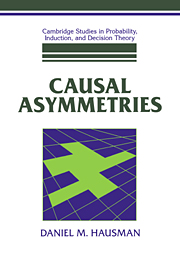Book contents
- Frontmatter
- Contents
- List of Figures
- Acknowledgments
- Introduction: Causation and its Asymmetries
- 1 Metaphysical Pictures and Wishes
- 1* Transfer Theories
- 2 Is Causation a Relation Among Events?
- 3 Causation, Regularities, and Time: Hume's Theory
- 4 Causation and Independence
- 4* Causation, Independence, and Causal Connection
- 5 Agency Theory
- 5* Causal Generalizations and Agency
- 6 The Counterfactual Theory
- 6* Independence and Counterfactual Dependence
- 7 Counterfactuals, Agency, and Independence
- 7* Agency, Counterfactuals, and Independence
- 8 Causation, Explanation, and Laws
- 8* Causation, Explanation, and Independent Alterability
- 9 Probabilistic Causation
- 10 Causation and Conditional Probabilities
- 10* Causal Graphs and Conditional Probabilistic Dependencies
- 11 Intervention, Robustness, and Probabilistic Dependence
- 11* Interventions and Conditional Probabilities
- 12 Operationalizing and Revising the Independence Theory
- 12* Probability Distributions and Causation
- 13 Complications and Conclusions
- Appendix A Alphabetical List of Propositions
- Appendix B List of Theorems
- References
- Index
7 - Counterfactuals, Agency, and Independence
Published online by Cambridge University Press: 20 April 2010
- Frontmatter
- Contents
- List of Figures
- Acknowledgments
- Introduction: Causation and its Asymmetries
- 1 Metaphysical Pictures and Wishes
- 1* Transfer Theories
- 2 Is Causation a Relation Among Events?
- 3 Causation, Regularities, and Time: Hume's Theory
- 4 Causation and Independence
- 4* Causation, Independence, and Causal Connection
- 5 Agency Theory
- 5* Causal Generalizations and Agency
- 6 The Counterfactual Theory
- 6* Independence and Counterfactual Dependence
- 7 Counterfactuals, Agency, and Independence
- 7* Agency, Counterfactuals, and Independence
- 8 Causation, Explanation, and Laws
- 8* Causation, Explanation, and Independent Alterability
- 9 Probabilistic Causation
- 10 Causation and Conditional Probabilities
- 10* Causal Graphs and Conditional Probabilistic Dependencies
- 11 Intervention, Robustness, and Probabilistic Dependence
- 11* Interventions and Conditional Probabilities
- 12 Operationalizing and Revising the Independence Theory
- 12* Probability Distributions and Causation
- 13 Complications and Conclusions
- Appendix A Alphabetical List of Propositions
- Appendix B List of Theorems
- References
- Index
Summary
In the previous two chapters I examined the relations among three theories of causation: the independence theory (CP), Lewis's counterfactual theory (L), and one version of an agency theory (ATg). That discussion left many loose ends, which this chapter takes up. In particular I need to say something about a token-level formulation of agency theory and about how agency theories and counterfactual theories relate to one another. This chapter also addresses a criticism of the independence condition, which one defender of an agency view has formulated as a criticism of Lewis's theory. Examining that criticism will show the centrality of independence to causation. This chapter ends by pulling together the defense of the independence theory scattered through previous chapters and summarizing the relations between time, agency, counterfactuals, and independence.
Agency, Counterfactuals, and Independence
Agency theories can be formulated as counterfactual token-level theories rather than (as in chapter 5) as type-level theories. Furthermore, the notion of an intervention helps counterfactual theories avoid counterexamples. One might wonder whether L might be derivable from some version of agency theory. Agency and counterfactual theorists might profitably join forces.
The following token-level formulation of agency theory is analogous to the type-level formulation of chapter 5:
AT (Agency theory) a causes b if and only if a and b are distinct, and if a had come about as a result of a direct manipulation, then that intervention would have been a cause of b.
One might want the results of interventions to provide truth conditions for a nontransitive relation of causal dependence and then define causation, as Lewis does, in terms of chains of causal dependence.
- Type
- Chapter
- Information
- Causal Asymmetries , pp. 139 - 150Publisher: Cambridge University PressPrint publication year: 1998



